Adventure Travel · Africa · Asia · Attractions · Central America · Congo, Democratic Republic of the · Costa Rica · Europe · Going Out · Hawaii · Iceland · Italy · Japan · North America · Regions · Speciality Travel · USA · Washington · Western Europe · Worldwide
9 of the best volcanoes to visit
What more says adventure and jaw dropping experience than the sight of an erupting volcano. The sheer splendour of watching the natural vibrant glow of molten rock seep or explode out of the earths crust is incredible and quite simply never gets boring!
 Across the globe we have many accessible volcanoes in near and far flung destinations that are becoming very popular to visit and plan your next holiday around. Be it the challenge of reaching a tricky summit climb, the incredible views you might be gazing out at, the volcano history with its stories of destruction and fights for survival or the engaging volcanic activity of lava, gases and ash. Here is a list Ive put together of some of the best volcanoes to visit across the world:
Mt Etna, Sicily, Italy – 3,350m
For UK residents Mt Etna is probably the easiest active volcano to visit. Located on the eastern coast of Sicily, it is easily approached from Catania airport. Many tourists like to include a day trip to Etna with a holiday to Taormina a beautiful, bustling coastal town. Excursion and local buses will take you to Etnas Refugio Sapienza, at a height of 2000m above sea level and from there you can either hike the remaining distance or fortunately there is a cable car and jeep option which most people tend to opt for. In late October I found I was hiking above the clouds through the ice a truly memorable experience!
Across the globe we have many accessible volcanoes in near and far flung destinations that are becoming very popular to visit and plan your next holiday around. Be it the challenge of reaching a tricky summit climb, the incredible views you might be gazing out at, the volcano history with its stories of destruction and fights for survival or the engaging volcanic activity of lava, gases and ash. Here is a list Ive put together of some of the best volcanoes to visit across the world:
Mt Etna, Sicily, Italy – 3,350m
For UK residents Mt Etna is probably the easiest active volcano to visit. Located on the eastern coast of Sicily, it is easily approached from Catania airport. Many tourists like to include a day trip to Etna with a holiday to Taormina a beautiful, bustling coastal town. Excursion and local buses will take you to Etnas Refugio Sapienza, at a height of 2000m above sea level and from there you can either hike the remaining distance or fortunately there is a cable car and jeep option which most people tend to opt for. In late October I found I was hiking above the clouds through the ice a truly memorable experience!
 Vesuvius, Italy 1,281m
Sitting as a backdrop to the population of Naples in southern Italy the volcano is an iconic landmark. Vesuvius is best known for the devastation it caused to the settlements of Pompeii and Herculaneum whereby it engulfed and buried these entire Roman cities back in AD 79. Today Pompeii is a UNESCO World Heritage Site and is one of Italys biggest tourist attractions exploring times gone by. To reach the summit of Vesuvius its an easy 30/40 minutes walk from where the buses / taxis drop you off. Looking down into the crater that is often still releasing gases, from the crater rim is an eerie and thrilling experience.
Vesuvius, Italy 1,281m
Sitting as a backdrop to the population of Naples in southern Italy the volcano is an iconic landmark. Vesuvius is best known for the devastation it caused to the settlements of Pompeii and Herculaneum whereby it engulfed and buried these entire Roman cities back in AD 79. Today Pompeii is a UNESCO World Heritage Site and is one of Italys biggest tourist attractions exploring times gone by. To reach the summit of Vesuvius its an easy 30/40 minutes walk from where the buses / taxis drop you off. Looking down into the crater that is often still releasing gases, from the crater rim is an eerie and thrilling experience.
 Kīlauea, Hawaii 1,247m
Kilauea is a highly active shield volcano in the Hawaiian Islands. It sits on the southern shore of the Big Island Hawaii. If you want to visit a volcano with constantly erupting lava this is definitely one to be seen! With options to see the lava via boat, by foot or indeed by helicopter there are plenty of opportunities to find the best way for you.
Kīlauea, Hawaii 1,247m
Kilauea is a highly active shield volcano in the Hawaiian Islands. It sits on the southern shore of the Big Island Hawaii. If you want to visit a volcano with constantly erupting lava this is definitely one to be seen! With options to see the lava via boat, by foot or indeed by helicopter there are plenty of opportunities to find the best way for you.
 Stromboli, Aeolian Islands, Italy 924m
Stromboli is a small volcanic island off the north coast of Sicily. The volcano dominates the island and provides a spectacle for all to see as its nickname Lighthouse of the Mediterranean infers. Excursions are run to hike the volcano just before dusk, so you can arrive at a viewing point to watch the volcano erupting by night. For those not keen on the challenge of the ascent, the eruptions can still often be seen from a boat trip.
Stromboli, Aeolian Islands, Italy 924m
Stromboli is a small volcanic island off the north coast of Sicily. The volcano dominates the island and provides a spectacle for all to see as its nickname Lighthouse of the Mediterranean infers. Excursions are run to hike the volcano just before dusk, so you can arrive at a viewing point to watch the volcano erupting by night. For those not keen on the challenge of the ascent, the eruptions can still often be seen from a boat trip.
 Eyjafjallajökull, Iceland 1,651m
The ice cap Eyjafjallajökul covers the caldera of a volcano which recently caused global chaos back in 2010. This volcano demonstrates the effects that volcanic activity can have across the world and albeit located on a fairly quiet and remote island the consequences can be seen globally. Overall Iceland is a geologists playground with so many fascinating geological structures and features, and is well worth a visit to explore the countrys spectacular waterfalls, hot springs, glaciers and volcanoes.
Eyjafjallajökull, Iceland 1,651m
The ice cap Eyjafjallajökul covers the caldera of a volcano which recently caused global chaos back in 2010. This volcano demonstrates the effects that volcanic activity can have across the world and albeit located on a fairly quiet and remote island the consequences can be seen globally. Overall Iceland is a geologists playground with so many fascinating geological structures and features, and is well worth a visit to explore the countrys spectacular waterfalls, hot springs, glaciers and volcanoes.
 Arenal Volcano, Costa Rica 1,670m
Located in the north west of Costa Rica the Arenal Volcano adopts the classic volcano shape making it a picture postcard holiday snap. The Arenal Volcano National Park protects both the Arenal Volcano and the dormant Chato Volcano. The expansive park stretches from near Lake Arenal and has both hiking trails and observational points for visitors to explore and enjoy.
Arenal Volcano, Costa Rica 1,670m
Located in the north west of Costa Rica the Arenal Volcano adopts the classic volcano shape making it a picture postcard holiday snap. The Arenal Volcano National Park protects both the Arenal Volcano and the dormant Chato Volcano. The expansive park stretches from near Lake Arenal and has both hiking trails and observational points for visitors to explore and enjoy.
 Mount Fuji, Tokyo 3,766m
Mt Fuji is situated on Honshu island about 100km south west of Japans capital Tokyo and on a clear day the grandeur of this mountain can be seen from there. Mount Fuji is an active volcano, which most recently erupted in 1707. The climbing season is from early July to mid September and you will find that this is when the trails and mountain facilities are open and are usually free of snow.
Mount Fuji, Tokyo 3,766m
Mt Fuji is situated on Honshu island about 100km south west of Japans capital Tokyo and on a clear day the grandeur of this mountain can be seen from there. Mount Fuji is an active volcano, which most recently erupted in 1707. The climbing season is from early July to mid September and you will find that this is when the trails and mountain facilities are open and are usually free of snow.
 Mt St Helens, USA 2,550m
The Cascade range forms a chain of volcanoes in the Pacific NW region of North America. It extends forming an arc for approximately 700 miles along a coastal path from British Columbia in Canada through to northern California. Mt St Helens is one of the 13 major volcanoes in this range and is probably most known for its major eruption in 1980 causing mass destruction and devastation. Two years after the event the Mount St Helens National Monument was created leaving the area as a protected environment reminding visitors of the impact this volcano had on the environment and the wonder of nature’s recovery.
Mt St Helens, USA 2,550m
The Cascade range forms a chain of volcanoes in the Pacific NW region of North America. It extends forming an arc for approximately 700 miles along a coastal path from British Columbia in Canada through to northern California. Mt St Helens is one of the 13 major volcanoes in this range and is probably most known for its major eruption in 1980 causing mass destruction and devastation. Two years after the event the Mount St Helens National Monument was created leaving the area as a protected environment reminding visitors of the impact this volcano had on the environment and the wonder of nature’s recovery.
 Nyiragongo, Democratic Republic of the Congo 3,470m
Mount Nyiragongo in the Virunga Mountains, is located inside Virunga National Park (Africas oldest national park and one of the most exciting). With enchanting forests, lava plains and active volcanoes, savannahs, swamps and glacial peaks this park is mesmerising. The park is known for its exceptional (bio)diversity, containing more bird, mammal and reptile species than any protected area on the African continent; and is one of the few remaining places where visitors can observe the critically endangered mountain gorilla in the wild. Part of a UNESCO World Heritage Site you can ascend to the rim of the crater and look down at the worlds largest lava lake. Every step up to the 3,470-metre-high peak is wholly worth it for the wonderful sight that greets you at the top!
Nyiragongo, Democratic Republic of the Congo 3,470m
Mount Nyiragongo in the Virunga Mountains, is located inside Virunga National Park (Africas oldest national park and one of the most exciting). With enchanting forests, lava plains and active volcanoes, savannahs, swamps and glacial peaks this park is mesmerising. The park is known for its exceptional (bio)diversity, containing more bird, mammal and reptile species than any protected area on the African continent; and is one of the few remaining places where visitors can observe the critically endangered mountain gorilla in the wild. Part of a UNESCO World Heritage Site you can ascend to the rim of the crater and look down at the worlds largest lava lake. Every step up to the 3,470-metre-high peak is wholly worth it for the wonderful sight that greets you at the top!
 Mike Kelly is Director at Oxford Private Travel.
If you would like to be a guest blogger on A Luxury Travel Blog in order to raise your profile, please contact us.
Mike Kelly is Director at Oxford Private Travel.
If you would like to be a guest blogger on A Luxury Travel Blog in order to raise your profile, please contact us.
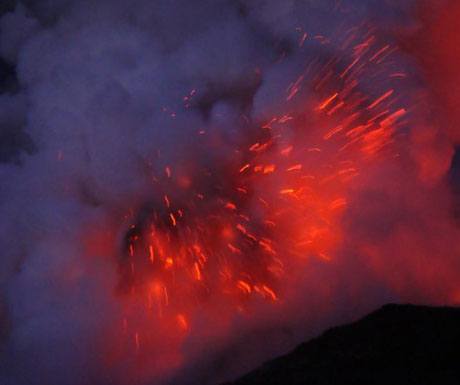 Across the globe we have many accessible volcanoes in near and far flung destinations that are becoming very popular to visit and plan your next holiday around. Be it the challenge of reaching a tricky summit climb, the incredible views you might be gazing out at, the volcano history with its stories of destruction and fights for survival or the engaging volcanic activity of lava, gases and ash. Here is a list Ive put together of some of the best volcanoes to visit across the world:
Mt Etna, Sicily, Italy – 3,350m
For UK residents Mt Etna is probably the easiest active volcano to visit. Located on the eastern coast of Sicily, it is easily approached from Catania airport. Many tourists like to include a day trip to Etna with a holiday to Taormina a beautiful, bustling coastal town. Excursion and local buses will take you to Etnas Refugio Sapienza, at a height of 2000m above sea level and from there you can either hike the remaining distance or fortunately there is a cable car and jeep option which most people tend to opt for. In late October I found I was hiking above the clouds through the ice a truly memorable experience!
Across the globe we have many accessible volcanoes in near and far flung destinations that are becoming very popular to visit and plan your next holiday around. Be it the challenge of reaching a tricky summit climb, the incredible views you might be gazing out at, the volcano history with its stories of destruction and fights for survival or the engaging volcanic activity of lava, gases and ash. Here is a list Ive put together of some of the best volcanoes to visit across the world:
Mt Etna, Sicily, Italy – 3,350m
For UK residents Mt Etna is probably the easiest active volcano to visit. Located on the eastern coast of Sicily, it is easily approached from Catania airport. Many tourists like to include a day trip to Etna with a holiday to Taormina a beautiful, bustling coastal town. Excursion and local buses will take you to Etnas Refugio Sapienza, at a height of 2000m above sea level and from there you can either hike the remaining distance or fortunately there is a cable car and jeep option which most people tend to opt for. In late October I found I was hiking above the clouds through the ice a truly memorable experience!
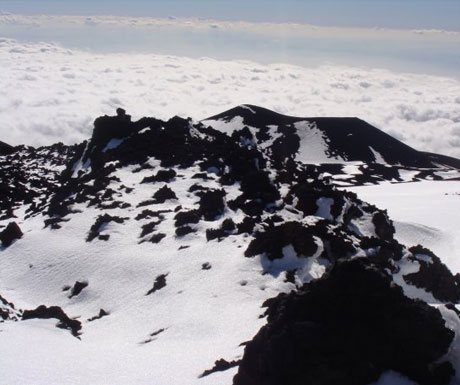 Vesuvius, Italy 1,281m
Sitting as a backdrop to the population of Naples in southern Italy the volcano is an iconic landmark. Vesuvius is best known for the devastation it caused to the settlements of Pompeii and Herculaneum whereby it engulfed and buried these entire Roman cities back in AD 79. Today Pompeii is a UNESCO World Heritage Site and is one of Italys biggest tourist attractions exploring times gone by. To reach the summit of Vesuvius its an easy 30/40 minutes walk from where the buses / taxis drop you off. Looking down into the crater that is often still releasing gases, from the crater rim is an eerie and thrilling experience.
Vesuvius, Italy 1,281m
Sitting as a backdrop to the population of Naples in southern Italy the volcano is an iconic landmark. Vesuvius is best known for the devastation it caused to the settlements of Pompeii and Herculaneum whereby it engulfed and buried these entire Roman cities back in AD 79. Today Pompeii is a UNESCO World Heritage Site and is one of Italys biggest tourist attractions exploring times gone by. To reach the summit of Vesuvius its an easy 30/40 minutes walk from where the buses / taxis drop you off. Looking down into the crater that is often still releasing gases, from the crater rim is an eerie and thrilling experience.
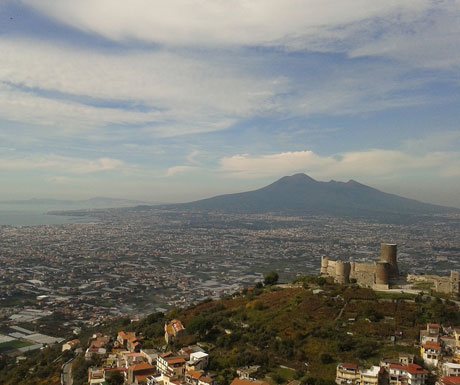 Kīlauea, Hawaii 1,247m
Kilauea is a highly active shield volcano in the Hawaiian Islands. It sits on the southern shore of the Big Island Hawaii. If you want to visit a volcano with constantly erupting lava this is definitely one to be seen! With options to see the lava via boat, by foot or indeed by helicopter there are plenty of opportunities to find the best way for you.
Kīlauea, Hawaii 1,247m
Kilauea is a highly active shield volcano in the Hawaiian Islands. It sits on the southern shore of the Big Island Hawaii. If you want to visit a volcano with constantly erupting lava this is definitely one to be seen! With options to see the lava via boat, by foot or indeed by helicopter there are plenty of opportunities to find the best way for you.
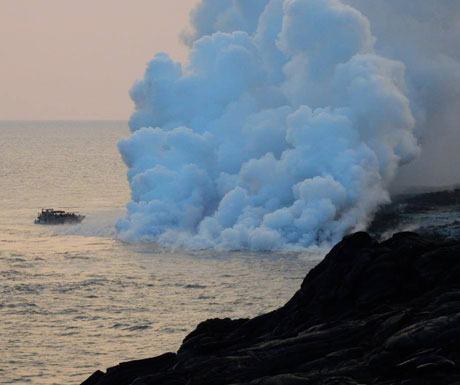 Stromboli, Aeolian Islands, Italy 924m
Stromboli is a small volcanic island off the north coast of Sicily. The volcano dominates the island and provides a spectacle for all to see as its nickname Lighthouse of the Mediterranean infers. Excursions are run to hike the volcano just before dusk, so you can arrive at a viewing point to watch the volcano erupting by night. For those not keen on the challenge of the ascent, the eruptions can still often be seen from a boat trip.
Stromboli, Aeolian Islands, Italy 924m
Stromboli is a small volcanic island off the north coast of Sicily. The volcano dominates the island and provides a spectacle for all to see as its nickname Lighthouse of the Mediterranean infers. Excursions are run to hike the volcano just before dusk, so you can arrive at a viewing point to watch the volcano erupting by night. For those not keen on the challenge of the ascent, the eruptions can still often be seen from a boat trip.
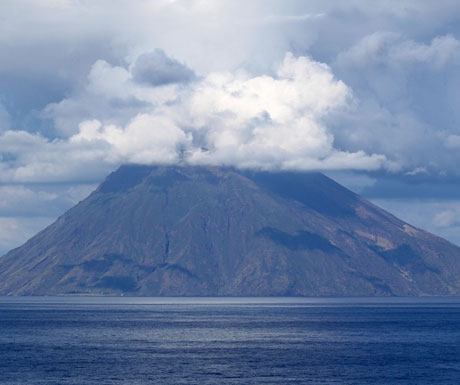 Eyjafjallajökull, Iceland 1,651m
The ice cap Eyjafjallajökul covers the caldera of a volcano which recently caused global chaos back in 2010. This volcano demonstrates the effects that volcanic activity can have across the world and albeit located on a fairly quiet and remote island the consequences can be seen globally. Overall Iceland is a geologists playground with so many fascinating geological structures and features, and is well worth a visit to explore the countrys spectacular waterfalls, hot springs, glaciers and volcanoes.
Eyjafjallajökull, Iceland 1,651m
The ice cap Eyjafjallajökul covers the caldera of a volcano which recently caused global chaos back in 2010. This volcano demonstrates the effects that volcanic activity can have across the world and albeit located on a fairly quiet and remote island the consequences can be seen globally. Overall Iceland is a geologists playground with so many fascinating geological structures and features, and is well worth a visit to explore the countrys spectacular waterfalls, hot springs, glaciers and volcanoes.
 Arenal Volcano, Costa Rica 1,670m
Located in the north west of Costa Rica the Arenal Volcano adopts the classic volcano shape making it a picture postcard holiday snap. The Arenal Volcano National Park protects both the Arenal Volcano and the dormant Chato Volcano. The expansive park stretches from near Lake Arenal and has both hiking trails and observational points for visitors to explore and enjoy.
Arenal Volcano, Costa Rica 1,670m
Located in the north west of Costa Rica the Arenal Volcano adopts the classic volcano shape making it a picture postcard holiday snap. The Arenal Volcano National Park protects both the Arenal Volcano and the dormant Chato Volcano. The expansive park stretches from near Lake Arenal and has both hiking trails and observational points for visitors to explore and enjoy.
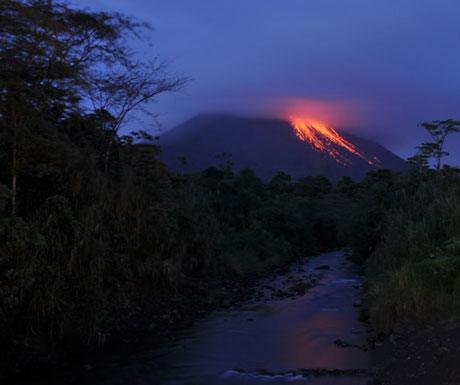 Mount Fuji, Tokyo 3,766m
Mt Fuji is situated on Honshu island about 100km south west of Japans capital Tokyo and on a clear day the grandeur of this mountain can be seen from there. Mount Fuji is an active volcano, which most recently erupted in 1707. The climbing season is from early July to mid September and you will find that this is when the trails and mountain facilities are open and are usually free of snow.
Mount Fuji, Tokyo 3,766m
Mt Fuji is situated on Honshu island about 100km south west of Japans capital Tokyo and on a clear day the grandeur of this mountain can be seen from there. Mount Fuji is an active volcano, which most recently erupted in 1707. The climbing season is from early July to mid September and you will find that this is when the trails and mountain facilities are open and are usually free of snow.
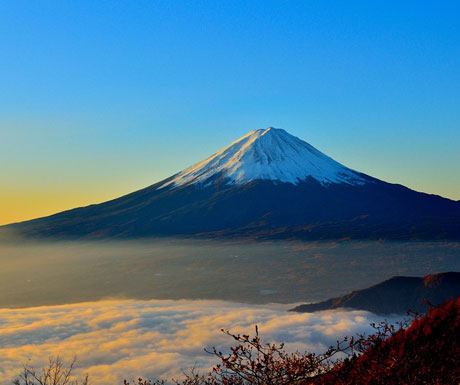 Mt St Helens, USA 2,550m
The Cascade range forms a chain of volcanoes in the Pacific NW region of North America. It extends forming an arc for approximately 700 miles along a coastal path from British Columbia in Canada through to northern California. Mt St Helens is one of the 13 major volcanoes in this range and is probably most known for its major eruption in 1980 causing mass destruction and devastation. Two years after the event the Mount St Helens National Monument was created leaving the area as a protected environment reminding visitors of the impact this volcano had on the environment and the wonder of nature’s recovery.
Mt St Helens, USA 2,550m
The Cascade range forms a chain of volcanoes in the Pacific NW region of North America. It extends forming an arc for approximately 700 miles along a coastal path from British Columbia in Canada through to northern California. Mt St Helens is one of the 13 major volcanoes in this range and is probably most known for its major eruption in 1980 causing mass destruction and devastation. Two years after the event the Mount St Helens National Monument was created leaving the area as a protected environment reminding visitors of the impact this volcano had on the environment and the wonder of nature’s recovery.
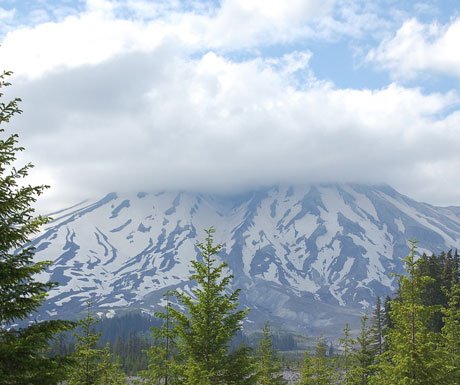 Nyiragongo, Democratic Republic of the Congo 3,470m
Mount Nyiragongo in the Virunga Mountains, is located inside Virunga National Park (Africas oldest national park and one of the most exciting). With enchanting forests, lava plains and active volcanoes, savannahs, swamps and glacial peaks this park is mesmerising. The park is known for its exceptional (bio)diversity, containing more bird, mammal and reptile species than any protected area on the African continent; and is one of the few remaining places where visitors can observe the critically endangered mountain gorilla in the wild. Part of a UNESCO World Heritage Site you can ascend to the rim of the crater and look down at the worlds largest lava lake. Every step up to the 3,470-metre-high peak is wholly worth it for the wonderful sight that greets you at the top!
Nyiragongo, Democratic Republic of the Congo 3,470m
Mount Nyiragongo in the Virunga Mountains, is located inside Virunga National Park (Africas oldest national park and one of the most exciting). With enchanting forests, lava plains and active volcanoes, savannahs, swamps and glacial peaks this park is mesmerising. The park is known for its exceptional (bio)diversity, containing more bird, mammal and reptile species than any protected area on the African continent; and is one of the few remaining places where visitors can observe the critically endangered mountain gorilla in the wild. Part of a UNESCO World Heritage Site you can ascend to the rim of the crater and look down at the worlds largest lava lake. Every step up to the 3,470-metre-high peak is wholly worth it for the wonderful sight that greets you at the top!
 Mike Kelly is Director at Oxford Private Travel.
If you would like to be a guest blogger on A Luxury Travel Blog in order to raise your profile, please contact us.
Mike Kelly is Director at Oxford Private Travel.
If you would like to be a guest blogger on A Luxury Travel Blog in order to raise your profile, please contact us.Did you enjoy this article?
Receive similar content direct to your inbox.

